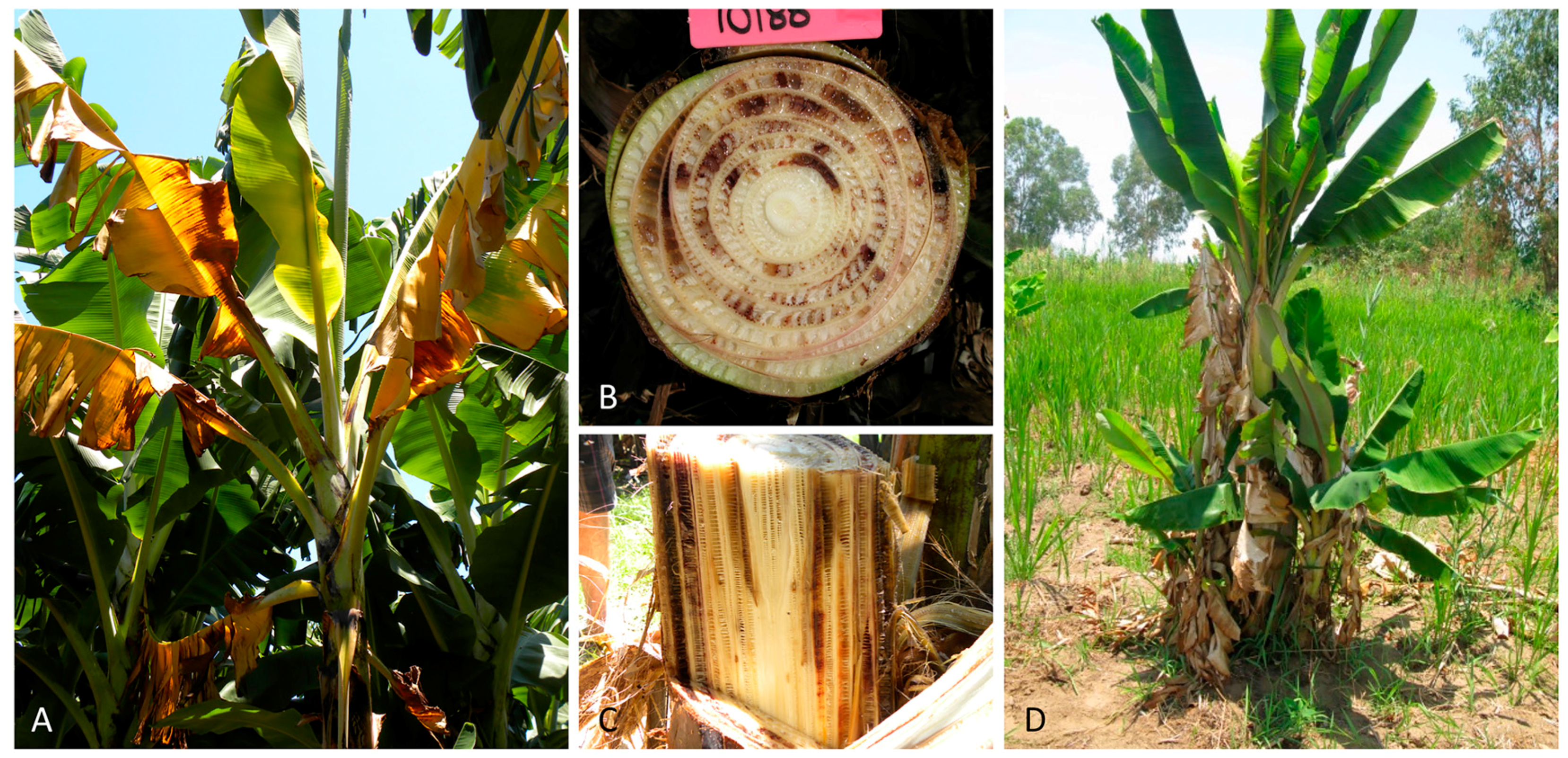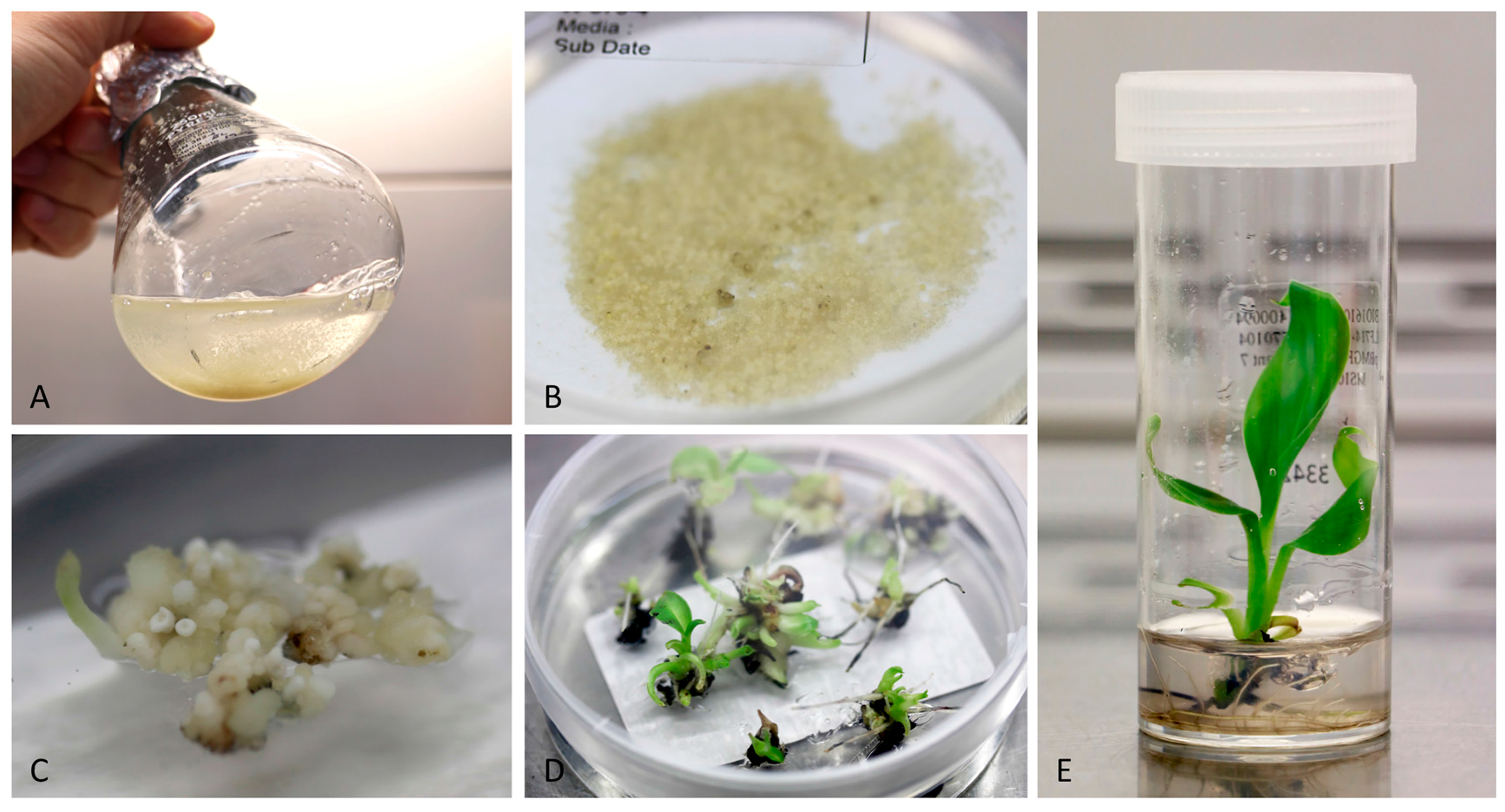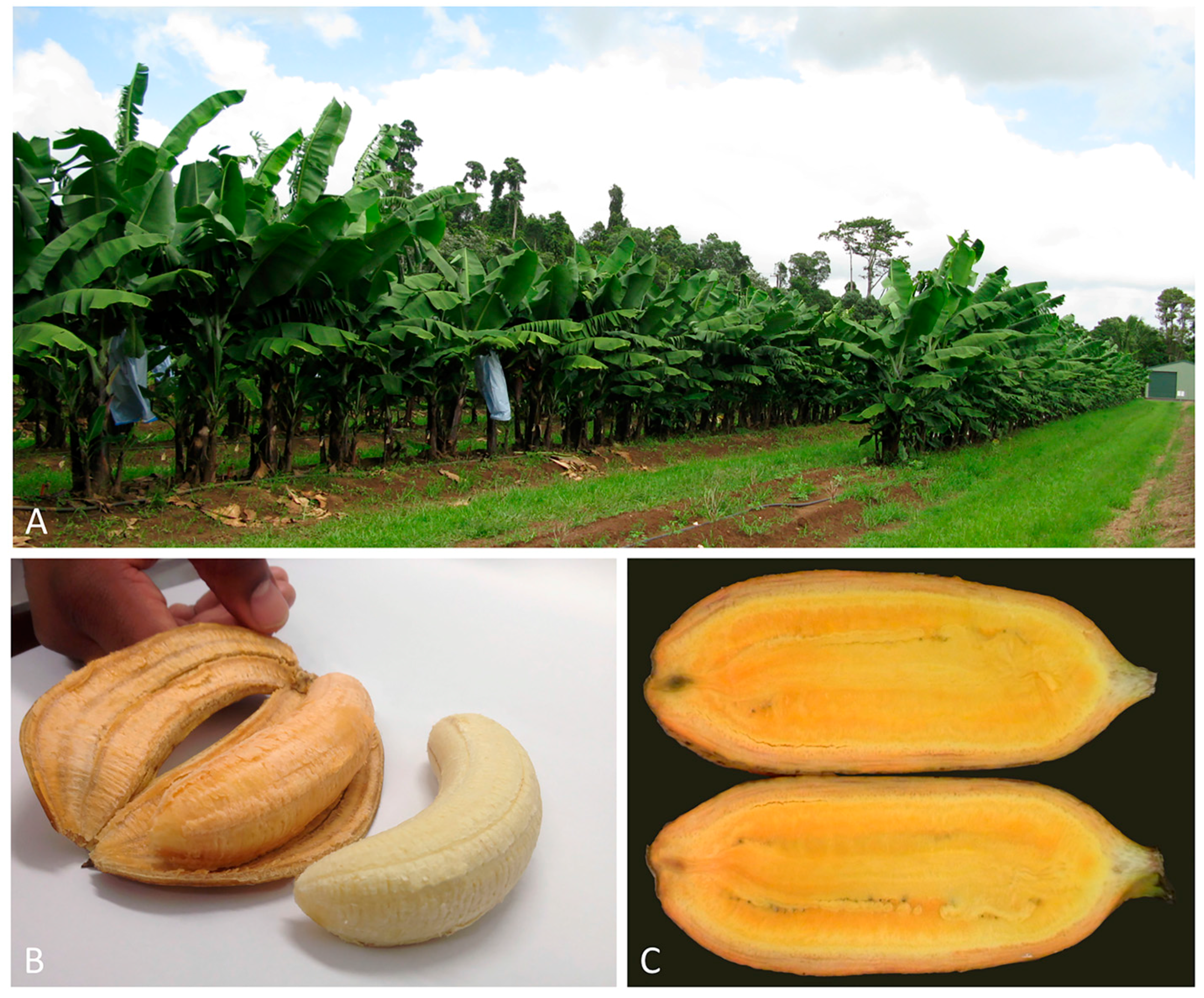Modifying Bananas: From Transgenics to Organics?
Abstract
1. About Bananas
2. The Challenges and Opportunities for Future Genetic Improvement
3. Conventional Breeding or Genetic Modification
4. The Progress with Genetically Modified Bananas
5. Banana GM and Organic Farming
Author Contributions
Conflicts of Interest
References
- Food and Agriculture Organization of the United Nations (FAOSTAT). Available online: http://www.fao.org/faostat/en/#data/QC (accessed on 15 August 2016).
- Ploetz, R.C.; Kepler, A.K.; Daniells, J.; Nelson, S.C. Banana and Plantain: An Overview with Emphasis on Pacific Island Cultivars. In Species Profiles for Pacific Island Agroforestry; Elevitch, C.R., Ed.; Permanent Agriculture Resources (PAR): Holualoa, HI, USA, 2007; Available online: http://agroforestry.org/images/pdfs/Banana-plantain-overview.pdf (accessed on 9 February 2017).
- Arias, P.; Dankers, C.; Liu, P.; Pilkauskas, P. Chapter 1: Overview of world banana production and trade. In The World Banana Economy 1985–2002; Food and Agriculture Organization of the United Nations: Rome, Italy, 2003. [Google Scholar]
- Alliance for a Green Revolution in Africa (AGRA). Africa Agriculture Status Report 2014: Climate Change and Smallholder Agriculture in Sub-Saharan Africa; AGRA: Nairobi, Kenya, 2014; Available online: https://ccafs.cgiar.org/publications/africa-agriculture-status-report-2014-climate-change-and-smallholder-agriculture-sub# (accessed on 9 August 2016).
- Denham, T.; Haberle, S.; Lentfer, C.J.; Fullagar, R.; Field, J.; Therin, M.; Porch, N.; Winsborough, B. Origins of Agriculture at Kuk Swamp in the Highlands of New Guinea. Science 2003, 301, 189–193. [Google Scholar] [CrossRef] [PubMed]
- Denham, T.; Haberle, S.; Lentfer, C.J. New evidence and revised interpretations of early agriculture in Highland New Guinea. Antiquity 2004, 78, 839–857. [Google Scholar] [CrossRef]
- Perrier, X.; De Langhe, E.; Donohue, M.; Lentfer, C.; Vrydaghs, L.; Bakry, F.; Carreel, F.; Hippolyte, I.; Horry, J.P.; Jenny, C.; et al. Multidisciplinary perspectives on banana (Musa spp.) domestication. Proc. Natl. Acad. Sci. USA 2011, 108, 11311–11318. [Google Scholar] [CrossRef] [PubMed]
- Ploetz, R.C. Fusarium wilt of banana. Phytopathology 2015, 105, 1512–1521. [Google Scholar] [CrossRef] [PubMed]
- Ploetz, R.C.; Evans, E.A. The Future of Global Banana Production. In Horticultural Reviews; Janick, J., Ed.; John Wiley & Sons, Inc.: Hoboken, NJ, USA, 2015; Volume 43, p. 311. [Google Scholar]
- Ploetz, R.C. Management of Fusarium wilt of banana: A review with special reference to tropical race 4. Crop Prot. 2015, 73, 7–15. [Google Scholar] [CrossRef]
- Simmonds, N.W. Bananas, 2nd ed.; Longmans: London, UK, 1966. [Google Scholar]
- Stover, R.H. Fusarial Wilt (Panama Disease) of Bananas and Other Musa Species; CMI: Kew, UK, 1962. [Google Scholar]
- Buddenhagen, I. Understanding strain diversity in Fusarium oxysporum f. sp. cubense and history of introduction of ‘Tropical Race 4’ to better manage banana production. Acta Hortic. 2009, 828, 193–204. [Google Scholar]
- Molina, A.; Fabregar, E.; Sinohin, V.G.; Herradura, L.; Fourie, G.; Viljoen, A. Confirmation of Tropical Race 4 of Fusarium oxysporum f. sp. cubense Infecting Cavendish Bananas in the Philippines. In Proceedings of the Centennial Meeting of the American Phytopathological Society, Minneapolis, MN, USA, 26–28 July 2008; Available online: https://cgspace.cgiar.org/handle/10568/674 (accessed on 2 August 2016).
- Queensland Government Department of Agriculture and Fisheries. A–Z List of Emergency Plant Pests and Diseases. Panama Disease. 2015. Available online: https://www.daf.qld.gov.au/plants/health-pests-diseases/a-z-significant/panama-disease2 (accessed on 1 September 2016). [Google Scholar]
- Syed, R.N.; Lodhi, A.M.; Jiskani, M.M.; Rajput, K.I.; Khaskheli, M.A.; Khanzada, M.A.; Rajput, N.A.; Maitlo, S.A.; Rajput, A.Q. First report of Panama wilt disease of banana caused by Fusarium oxysporum f. sp. cubense in Pakistan. J. Plant Pathol. 2015, 97, 213. [Google Scholar] [CrossRef]
- Ordonez, N.; Seidl, M.F.; Waalwijk, C.; Drenth, A.; Kilian, A.; Thomma, B.P.; Ploetz, R.C.; Kema, G.H.J. Worse comes to worst: Bananas and Panama disease—When plant and pathogen clones meet. PLoS Pathog. 2015, 11, e1005197. [Google Scholar] [CrossRef] [PubMed]
- García-Bastidas, F.; Ordóñez, N.; Konkol, J.; Al-Qasim, M.; Naser, Z.; Abdelwali, M.; Salem, N.; Waalwijk, C.; Ploetz, R.C.; Kema, G.H.J. First report of Fusarium oxysporum f. sp. cubense Tropical Race 4 associated with Panama disease of banana outside Southeast Asia. Plant Dis. 2013, 98, 694. [Google Scholar] [CrossRef]
- Butler, D. Fungus threatens top banana. Nature 2013, 504, 195–196. [Google Scholar] [CrossRef] [PubMed]
- Hwang, S.C.; Ko, W.H. Cavendish banana cultivars resistant to Fusarium wilt acquired through somaclonal variation in Taiwan. Plant Dis. 2004, 88, 580–587. [Google Scholar] [CrossRef]
- Arango Isaza, R.E.; Diaz-Trujillo, C.; Dhillon, B.; Aerts, A.; Carlier, J.; Crane, C.F.; de Jong, T.V.; De Vries, I.; Dietrich, R.; Farmer, A.D.; et al. Combating a Global Threat to a Clonal Crop: Banana Black Sigatoka Pathogen Pseudocercospora fijiensis (Synonym Mycosphaerella fijiensis) Genomes Reveal Clues for Disease Control. PLoS Genet. 2016, 12, e1005876. [Google Scholar] [CrossRef] [PubMed]
- Dale, J.L. Banana bunchy top—An economically important tropical plant virus disease. Adv. Virus Res. 1987, 33, 301–325. [Google Scholar] [PubMed]
- Harding, R.M.; Burns, T.M.; Dale, J.L. Virus-Like Particles Associated with Banana Bunchy Top Disease Contain Small Single-Stranded DNA. J. Gen. Virol. 1991, 72, 225–230. [Google Scholar] [CrossRef] [PubMed]
- Adegbola, R.O.; Ayodeji, O.; Awosusi, O.O.; Atiti, G.I.; Kumar, P. First report of Banana bunchy top virus in Banana and Plantain (Musa spp.) in Nigeria. Plant Dis. 2013, 97, 290. [Google Scholar] [CrossRef]
- Blomme, G.; Ploetz, R.; Jones, D.; De Langhe, E.; Price, N.; Gold, C.; Geering, A.; Viljoen, A.; Karamura, D.; Pillay, M.; et al. A historical overview of the appearance and spread of Musa pests and pathogens on the African continent: Highlighting the importance of clean Musa planting materials and quarantine measures. Ann. Appl. Biol. 2013, 162, 4–26. [Google Scholar] [CrossRef]
- Kumar, P.L.; Hanna, R.; Alabi, O.J.; Soko, M.M.; Oben, T.T.; Vangu, G.H.P.; Naidu, R.A. Banana bunchy top virus in sub-Saharan Africa: Investigations on virus distribution and diversity. Virus Res. 2011, 159, 171–182. [Google Scholar] [CrossRef] [PubMed]
- Eden-Green, S. How can the advance of banana Xanthomonas wilt be halted? InfoMusa 2004, 13, 38–41. [Google Scholar]
- Uganda Bureau of Statistics (UBOS). Uganda Demographic and Health Survey 2006; UBOS: Kampala, Uganda; Macro International Inc.: Calverton, MD, USA, 2006; Available online: http://www.dhsprogram.com/pubs/pdf/FR194/FR194.pdf (accessed on 28 July 2016).
- Uganda Bureau of Statistics (UBOS). Uganda Demographic and Health Survey 2011; UBOS: Kampala, Uganda; MEASURE DHS ICF International: Calverton, MD, USA, 2011; Available online: https://dhsprogram.com/pubs/pdf/FR264/FR264.pdf (accessed on 28 July 2016).
- HarvestPlus. Disseminating Orange-Fleshed Sweet Potato: Uganda Country Report; HarvestPlus: Washington, DC, USA, 2012. [Google Scholar]
- Dale, J.; Tushemereirwe, W. Development of bananas with optimised bioavailable micronutrients. In Grand Challenges in Global Health: 2005–2015. A 10-Year Retrospective of 14 of the 44 Original Projects; 2015; pp. 106–113. Available online: http://gcgh.grandchallenges.org/sites/default/files/gf%2010%20years%20p7%20111615%20intro.pdf (accessed on 23 February 2017).
- Sayre, R.; Beeching, J.R.; Cahoon, E.B.; Egesi, C.; Fauquet, C.; Fellman, J.; Fregene, M.; Gruissem, W.; Mallowa, S.; Manary, M.; et al. The BioCassava Plus program: Biofortification of cassava for Sub-Saharan Africa. Annu. Rev. Plant Biol. 2011, 62, 251–272. [Google Scholar] [CrossRef] [PubMed]
- Elitzur, T.; Yakir, E.; Quansah, L.; Zhangjun, F.; Vrebalov, J.; Khayat, E.; Giovannoni, J.J.; Friedman, H. Banana MaMADS transcription factors are necessary for fruit ripening and molecular tools to promote shelf-life and food security. Plant Physiol. 2016, 171, 380–391. [Google Scholar] [CrossRef] [PubMed]
- Ahmad, P.; Ashraf, M.; Younis, M.; Hu, X.; Kumar, A.; Akram, N.A.; Al-Qurainy, F. Role of transgenic plants in agriculture and biopharming. Biotechnol. Adv. 2012, 30, 524–540. [Google Scholar] [CrossRef] [PubMed]
- Lisko, K.A.; Torres, R.; Harris, R.S.; Belisle, M.; Vaughan, M.M.; Jullian, B.; Chevone, B.I.; Mendes, P.; Nessler, C.L.; Lorence, A. Elevating vitamin C content via overexpression of myo-inositol oxygenase and l-gulono-1,4-lactone oxidase in Arabidopsis leads to enhanced biomass and tolerance to abiotic stresses. In Vitro Cell Dev. Biol. Plant. 2013, 49, 643–655. [Google Scholar] [CrossRef] [PubMed]
- Damodaran, T.; Kumar, N.; Kavino, M. Breeding and evaluation of Musa hybrids resistant to Fusarium oxysporum f. sp. cubense race 1. Fruits 2009, 64, 3–12. [Google Scholar] [CrossRef]
- Li, W.M.; Dita, M.; Wu, W.; Hu, G.B.; Xie, J.H.; Ge, X.J. Resistance sources to Fusarium oxysporum f. sp. cubense tropical race 4 in banana wild relatives. Plant Pathol. 2015, 64, 1061–1067. [Google Scholar]
- Nowakunda, K.; Barekye, A.; Ssali, R.T.; Namaganda, J.; Tushemereirwe, W.K.; Nabulya, G.; Erima, R.; Akankwasa, K.; Hilman, E.; Batte, M.; et al. ‘Kiwangaazi’ (syn ‘KABANA 6H’) Black Sigatoka nematode and banana weevil tolerant ‘Matooke’ hybrid banana released in Uganda. Hortic. Sci. 2015, 50, 621–623. [Google Scholar]
- Ortiz, R.; Vuylsteke, D. Inheritance of black sigatoka disease resistance in plantain-banana (Musa spp.) hybrids. Theor. Appl. Genet. 1994, 89, 146–152. [Google Scholar] [CrossRef] [PubMed]
- Ssali, R.T.; Kiggundu, A.; Lorenzen, J.; Karamura, E.; Tushemereirwe, W.; Viljoen, A. Inheritance of resistance to Fusarium oxysporum f. sp. cubense race 1 in bananas. Euphytica 2013, 194, 425–430. [Google Scholar] [CrossRef]
- Iskra-Caruana, M.L.; Duroy, P.O.; Chabannes, M.; Muller, E. The common evolutionary history of badnaviruses and banana. Infect. Genet. Evol. 2014, 21, 83–89. [Google Scholar] [CrossRef] [PubMed]
- Arias, P.; Dankers, C.; Liu, P.; Pilkauskas, P. The World Banana Economy (1985–2002); FAO: Rome, Italy, 2003; Available online: http://www.fao.org/docrep/007/y5102e/y5102e04.htm (accessed on 17 August 2016).
- Banana Market Review and Banana Statistics (2012 and 2013). Food and Agricultural Organization of the United Nations, 2014. Available online: http://www.fao.org/docrep/019/i3627e/i3627e.pdf (accessed on 15 August 2016).
- Shekhawat, U.K.S.; Ganapathi, T.R.; Hadapad, A.B. Transgenic banana plants expressing small interfering RNAs targeted against viral replication initiation gene display high-level resistance to banana bunchy top virus infection. J. Gen. Virol. 2012, 93, 1804–1813. [Google Scholar] [CrossRef] [PubMed]
- Namukwaya, B.; Tripathi, L.; Tripathi, J.N.; Arinaitwe, G.; Mukasa, S.B.; Tushemereirwe, W.K. Transgenic banana expressing Pflp gene confers enhanced resistance to Xanthomonas wilt disease. Transgen. Res. 2012, 21, 855–865. [Google Scholar] [CrossRef] [PubMed]
- Tripathi, L.; Mwaka, K.; Tripathi, J.N.; Tushemereirwe, W.K. Expression of sweet pepper Hrap gene in banana enhances resistance to Xanthomonas campestris pv. musacearum. Mol. Plant Pathol. 2010, 11, 721–731. [Google Scholar] [PubMed]
- Tripathi, L.; Tripathi, J.N.; Kiggundu, A.; Korie, S.; Shotkoski, F.; Tushemereirwe, W.K. Field trial of Xanthomonas wilt disease-resistant bananas in East Africa. Nat. Biotechnol. 2014, 32, 868–870. [Google Scholar] [CrossRef] [PubMed]
- Umber, M.; Pichaut, J.P.; Farinas, B.; Laboureau, N.; Janzac, B.; Plaisir-Pineau, K.; Pressat, G.; Baurens, F.C.; Chabannes, M.; Duroy, P.O.; et al. Marker-assisted breeding of Musa balbisiana genitors devoid of infectious endogenous Banana streak virus sequences. Mol. Breed. 2016, 36, 1–11. [Google Scholar] [CrossRef]
- Khanna, H.; Becker, D.; Kleidon, J.; Dale, J.L. Centrifugation assisted Agrobacterium tumefaciens-mediated transformation (CAAT) of embryogenic cell suspensions of banana (Musa spp. Cavendish AAA and Lady finger AAB). Mol. Breed. 2004, 14, 239–252. [Google Scholar] [CrossRef]
- Becker, K.D.; Dugdale, B.; Smith, K.M.; Harding, R.M.; Dale, J.L. Genetic transformation of Cavendish banana (Musa spp. AAA group) cv ‘Grand Nain’ via microprojectile bombardment. Plant Cell Rep. 2000, 19, 229–234. [Google Scholar] [CrossRef]
- Ortiz, R.; Swennen, R. From crossbreeding to biotechnology-facilitated improvement of banana and plantain. Biotechnol. Adv. 2014, 32, 158–169. [Google Scholar] [CrossRef] [PubMed]
- D’Hont, A.; Denoeud, F.; Aury, J.-M.; Baurens, F.-C.; Carreel, F.; Garsmeur, O.; Noel, B.; Bocs, S.; Droc, G.; Rouard, M. The banana (Musa acuminata) genome and the evolution of monocotyledonous plants. Nature 2012, 488, 213–217. [Google Scholar] [CrossRef] [PubMed]
- Davey, M.W.; Gudimella, R.; Harikrishna, J.A.; Sin, L.W.; Khalid, N.; Keulemans, J. A draft Musa balbisiana genome sequence for molecular genetics in polyploid, inter- and intra-specific Musa hybrids. BMC Genom. 2013, 14, 1–20. [Google Scholar] [CrossRef] [PubMed]
- Asif, M.H.; Lakhwani, D.; Pathak, S.; Gupta, P.; Bag, S.K.; Nath, P.; Trivedi, P.K. Transcriptome analysis of ripe and unripe fruit tissue of banana identifies major metabolic networks involved in fruit ripening process. BMC Plant Biol. 2014, 14, 1–15. [Google Scholar] [CrossRef] [PubMed]
- Li, C.; Shao, J.; Wang, Y.; Li, W.; Guo, D.; Yan, B.; Xia, Y.; Peng, M. Analysis of banana transcriptome and global gene expression profiles in banana roots in response to infection by race 1 and tropical race 4 of Fusarium oxysporum f. sp. cubense. BMC Genom. 2013, 14, 1–16. [Google Scholar] [CrossRef] [PubMed]
- Wang, Z.; Zhang, J.; Jia, C.; Liu, J.; Li, Y.; Yin, X.; Xu, B.; Jin, Z. De novo characterization of the banana root transcriptome and analysis of gene expression under Fusarium oxysporum f. sp. cubense tropical race 4 infection. BMC Genom. 2012, 13, 650. [Google Scholar] [CrossRef]
- Cardi, T.; Stewart, N., Jr. Progress of targeted genome modification approaches in higher plants. Plant Cell Rep. 2016, 35, 1401–1416. [Google Scholar] [CrossRef] [PubMed]
- Paul, J.W., III; Qi, Y. CRISPR/Cas9 for plant genome editing: Accomplishments, problems and prospects. Plant Cell Rep. 2016, 35, 1417–1427. [Google Scholar] [CrossRef] [PubMed]
- Mwari, B. Development of Banana Bunchy Top Virus Resistance in Bananas: RNAi Approach. Ph.D. Thesis, Queensland University of Technology, Brisbane, Australia, 2016. [Google Scholar]
- Paul, J.-Y.; Becker, D.K.; Dickman, M.B.; Harding, R.M.; Khanna, H.K.; Dale, J.L. Apoptosis-related genes confer resistance to Fusarium wilt in transgenic ‘Lady Finger’ bananas. Plant Biotechnol. J. 2011, 9, 1141–1148. [Google Scholar] [CrossRef] [PubMed]
- Ghag, S.B.; Shekhawat, U.K.S.; Ganapathi, T.R. Host-induced post-transcriptional hairpin RNA-mediated gene silencing of vital fungal genes confers efficient resistance against Fusarium wilt in banana. Plant Biotechnol. J. 2014, 12, 541–553. [Google Scholar] [CrossRef] [PubMed]
- Ghag, S.B.; Shekhawat, U.K.S.; Ganapathi, T.R. Transgenic banana plants expressing a Stellaria media defensin gene (Sm-AMP-D1) demonstrate improved resistance to Fusarium oxysporum. Plant Cell Tissue Org. 2014, 119, 247–255. [Google Scholar] [CrossRef]
- Tripathi, L.; Babirye, A.; Roderick, H.; Tripathi, J.N.; Changa, C.; Urwin, P.E.; Tushemereirwe, W.K.; Coyne, D.; Atkinson, H.J. Field resistance of transgenic plantain to nematodes has potential for future African food security. Nat. Sci. Rep. 2015, 5, 8127. [Google Scholar] [CrossRef] [PubMed]
- Shekhawat, U.K.S.; Ganapathi, T.R. MusaWRKY71 overexpression in banana plants leads to altered abiotic and biotic stress responses. PLoS ONE 2013, 8, e75506. [Google Scholar] [CrossRef] [PubMed]
- Tripathi, L.; (IITA, Nairobi, Kenya). Personal communication, 2016.
- Peraza-Echeverria, S. Molecular Cloning and Characterisation of Potential Fusarium Resistance Genes in Banana (Musa acuminata ssp. malaccensis). Ph.D. Thesis, Queensland University of Technology, Brisbane, Australia, 2007. [Google Scholar]
- Peraza-Echeverria, S.; Dale, J.L.; Harding, R.M.; Collet, C. Molecular cloning and in silico analysis of potential Fusarium resistance genes in banana. Mol. Breed. 2009, 23, 431–443. [Google Scholar] [CrossRef]
- De Lapeyre De Bellaire, L.; Fouré, E.; Abadie, C.; Carlier, J. Black Leaf Streak Disease is challenging the banana industry. Fruits 2010, 65, 327–342. [Google Scholar] [CrossRef]



© 2017 by the authors. Licensee MDPI, Basel, Switzerland. This article is an open access article distributed under the terms and conditions of the Creative Commons Attribution (CC BY) license ( http://creativecommons.org/licenses/by/4.0/).
Share and Cite
Dale, J.; Paul, J.-Y.; Dugdale, B.; Harding, R. Modifying Bananas: From Transgenics to Organics? Sustainability 2017, 9, 333. https://doi.org/10.3390/su9030333
Dale J, Paul J-Y, Dugdale B, Harding R. Modifying Bananas: From Transgenics to Organics? Sustainability. 2017; 9(3):333. https://doi.org/10.3390/su9030333
Chicago/Turabian StyleDale, James, Jean-Yves Paul, Benjamin Dugdale, and Robert Harding. 2017. "Modifying Bananas: From Transgenics to Organics?" Sustainability 9, no. 3: 333. https://doi.org/10.3390/su9030333
APA StyleDale, J., Paul, J.-Y., Dugdale, B., & Harding, R. (2017). Modifying Bananas: From Transgenics to Organics? Sustainability, 9(3), 333. https://doi.org/10.3390/su9030333





